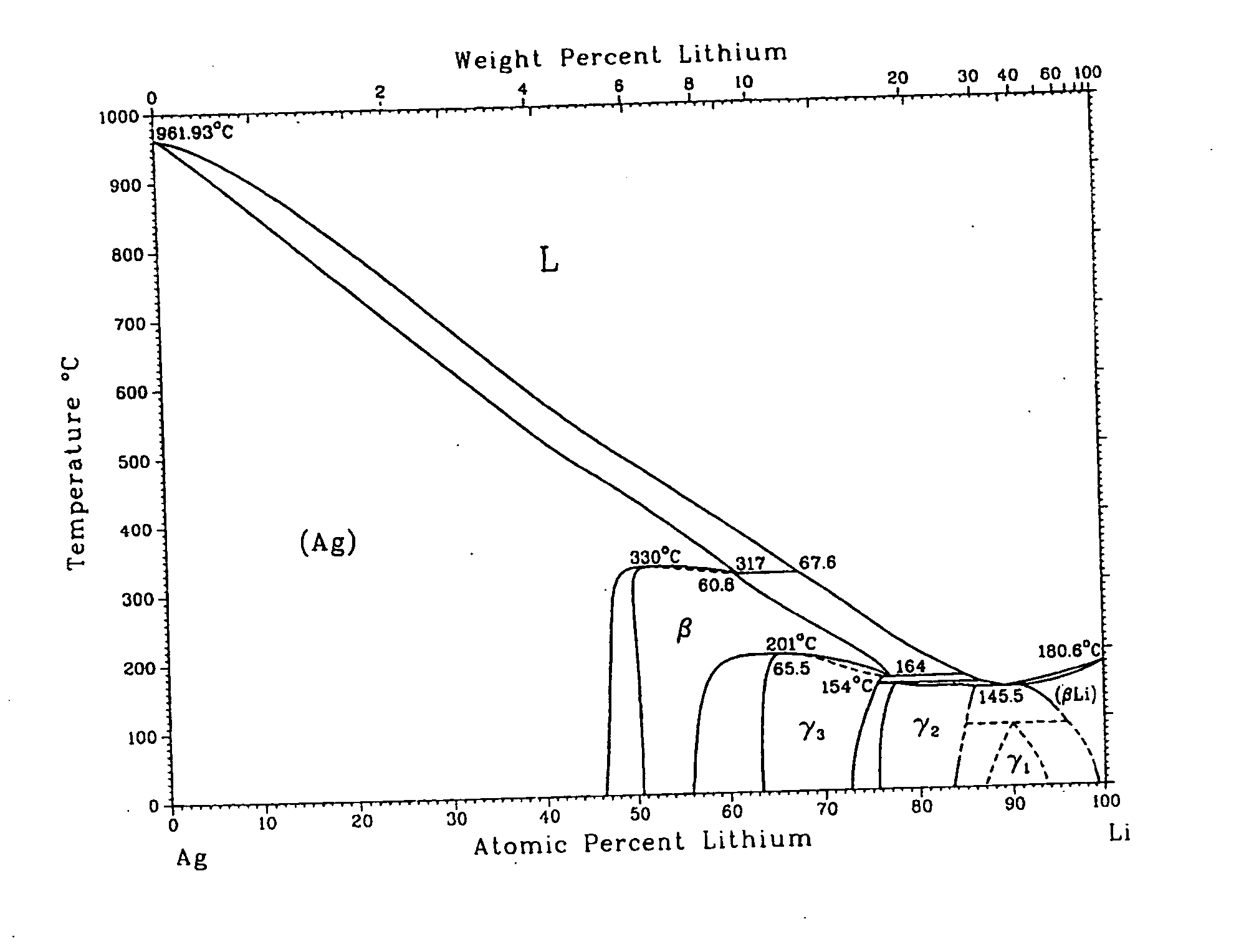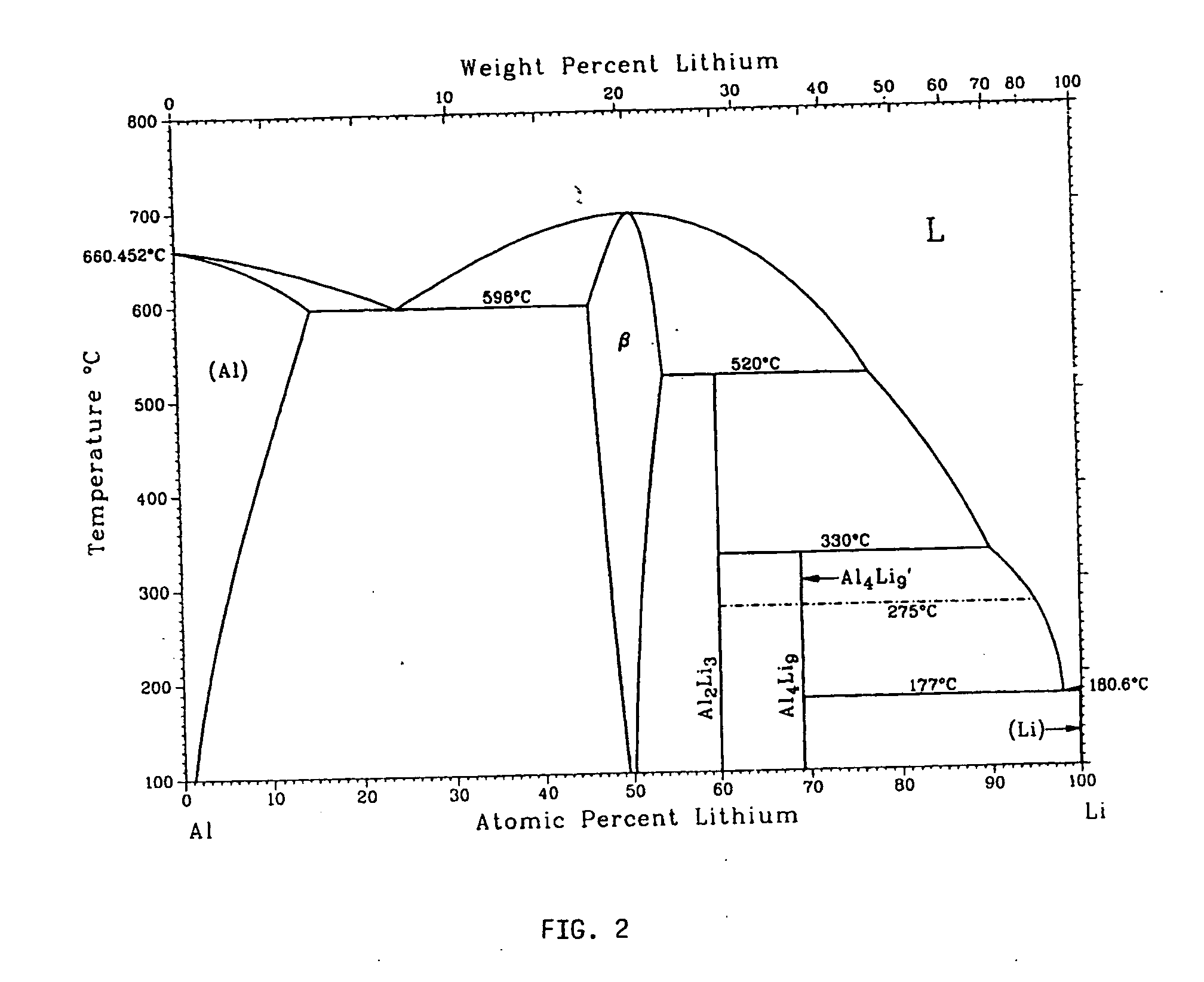Metallic gas sorbents on the basis of lithium alloys
a technology of lithium alloys and gas sorbents, which is applied in the field of metal gas sorbents on the basis of lithium alloys, can solve the problems of high temperature required for titanium evaporation, low value of sticking coefficient of some residual gases, and inability to achieve the effect of reducing improving the mechanical rigidity of alloys, and reducing the temperature boundary of solid states
- Summary
- Abstract
- Description
- Claims
- Application Information
AI Technical Summary
Benefits of technology
Problems solved by technology
Method used
Image
Examples
example 1
[0117] For the production of wire vapor sources of Li on the basis of Cu—15 at % Li alloys, lithium metal of the purity of 99.9% (Chemetal GmbH, Lithium foil) and copper metal of the purity of 99.999% (Alfa Aesar, Puratronic, Copper shot) were used as initial materials. These components were subjected to preliminary cleaning by vacuum remelting under the following conditions: for lithium an exposure for 2 hours at 300° C. under the pressure of 10−6 mbar, for copper an exposure for 2-3 hours at 1100° C. under the pressure of 10−4 mbar, both under an initial atmosphere of pure argon.
[0118] The cleaned metals, 103.7 g of copper and 2.0 g of lithium, were charged into thin walled stainless steel tubes (with the diameter of 12.7 mm and a wall thickness of 0.35 mm) in a glove box under argon, after which the ends of the tubes were sealed off under vacuum (FIG. 11), leaving inside the tube free space, which exceeded the volume of the alloy by 3-4 times.
[0119] The obtained metallic ampoul...
example 2
[0122] For a demonstration of the sorption properties of the Li-films, a strip of the thickness of 1 mm was made from an ingot of Ag—25 at % Li with the help of the method described in Example 1. The strip was then rolled into a foil of the thickness of 0.1 mm (FIG. 12). A 6 mm long and 0.6 mm wide ribbon was cut out of this foil. The ribbon was connected to the electrodes of a vacuum test chamber (Dr. J. {hacek over (S)}etina, IMT, Ljubljana), the chamber was pumped down to a pressure level lower than 10−6 mbar under heating to 300° C. and cooled down to room temperature; by heating the ribbon with an electric current to the temperature of ˜600° C. lithium was evaporated onto a cylindrical substrate. Then according to a standard procedure (see ASTM International. Standard Practice for Determining Gettering Rate, Sorption Capacity, and Gas Content of Nonevaporable Getters in the Molecular Flow Region) the sorption of CO2 by the lithium film was measured at room temperature. The resu...
example 3
[0123] A 6 cm long Cu—14 at % Li wire with a diameter of 0.5 mm was suspended inside a stainless steel cylinder, which was installed in a vacuum chamber. The chamber was pumped down to the pressure of 10−6 mbar, after which the wire was heated with current to evaporate lithium. The first lithium deposition onto the stainless steel substrate cylinder was performed under the temperature of 632° C. during 13.5 min, after which the stainless steel cylinder was replaced by the new one. The second deposition was done at 795° C. during 5.7 min.
[0124] The quantity of evaporated metal was defined by washing the lithium film from the surface of the substrate cylinder with pure water and the further measuring of lithium concentration in water solution according to Flame Atomic Absorption Spectrometer (FAAS—Perkin Elmer 2380). In the first case the determined mass of Li was 0.018 mg, corresponds to the average evaporation rate of 2.22×10−5 mg / s, in the second case the mass of Li was 0.009 mg, ...
PUM
| Property | Measurement | Unit |
|---|---|---|
| temperature | aaaaa | aaaaa |
| temperature | aaaaa | aaaaa |
| threshold temperature | aaaaa | aaaaa |
Abstract
Description
Claims
Application Information
 Login to View More
Login to View More - R&D
- Intellectual Property
- Life Sciences
- Materials
- Tech Scout
- Unparalleled Data Quality
- Higher Quality Content
- 60% Fewer Hallucinations
Browse by: Latest US Patents, China's latest patents, Technical Efficacy Thesaurus, Application Domain, Technology Topic, Popular Technical Reports.
© 2025 PatSnap. All rights reserved.Legal|Privacy policy|Modern Slavery Act Transparency Statement|Sitemap|About US| Contact US: help@patsnap.com



